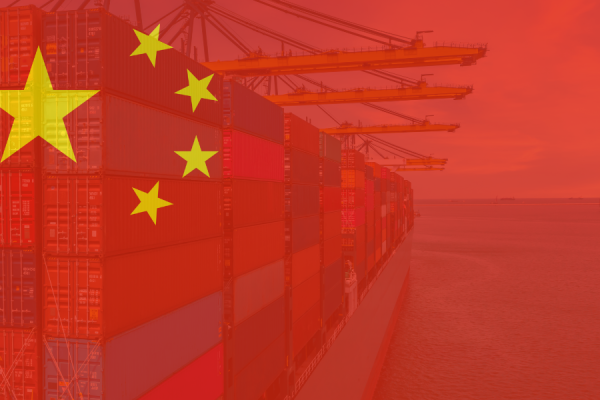
Shirley Wu
Published: October 15, 2025
On 10 October 2025, the Ministry of Transport of China announced the imposition of special port dues on vessels with significant U.S. connections, with effect from 14 October 2025. Whilst this measure responds to U.S. port fee actions under Section 301 announced by the United States Trade Representative (USTR) on 17 April 2025, and is said to aim at safeguarding China’s maritime interests, the impact has the potential to be far more wide reaching given the role of the U.S. stock exchange and U.S. private equity. The implementation of the counter measure will further impact voyage planning and cost structures for affected operators. This article provides a short summary of the key highlights of the new measure for Members’ guidance.
Scope of Application
The special port dues apply to vessels:
- owned or operated by U.S. enterprises, other organisations or individuals;
- owned or operated by enterprises, other organisations in which US enterprises, other organisations or individuals directly or indirectly hold 25% or more of its equity, voting rights or board representation
- flying the U.S. flag; or
- built in the United States.
The following key questions remain unresolved:
Definition of “US enterprises, other organisations and individuals” and “U.S.-based”
What exactly constitutes these terms? Under the USTR Port Fees regime, the U.S. has looked beyond a company’s place of incorporation. It is expected that Chinese authorities will adopt a similar approach, considering other forms of registration, business presence, and economic substance when determining applicability of the Chinese Countermeasures.
Criteria for identifying vessels “owned” or “operated” by US entities or individuals
What legal definitions and standards will Chinese authorities apply in this context? How will the 25% threshold be measured? Clarification on these issues is particularly important for vessels owned or operated by large conglomerates with complex corporate structures.
Treatment of different chartering arrangements
How will Chinese authorities address vessels operated under various chartering models? Will this apply only to bareboat charters, or also include time charters, slot exchanges, or management agreements? This requires analyzing the nature and terms of each arrangement and the parties involved. In particular, technical and commercial aspects of operation may vary significantly on a case-by-case basis, especially in time chartering scenarios.
Exemptions
Vessels falling within the abovementioned categories are nevertheless eligible for exemption if they are:
- built in China;
- entering Chinese shipyards for repairs in ballast only; or
- qualify for exemptions on other grounds subject to the maritime authorities’ approval.
The third category of exemption seems to leave room for further interpretation. There may be vessels in other categories which may potentially be eligible for exemption—such as those performing humanitarian rescue, emergency medical services, search and rescue missions, or vessels entering Chinese ports due to distress. Relevant shipowners or operators may attempt to apply to the Maritime Safety Administration (MSA) to seek clarification or apply for exemption.
Fee Structure
Mirroring the USTR regulations, the special port dues will be levied on a per-voyage basis. For voyages involving multiple Chinese port calls, the dues will be collected at the first port of entry. Each vessel will be subject to a maximum of five chargeable voyages per year, with the fee amount escalating annually every April.
The applicable rates will be increased in phases according to the following time scale:
- For vessels calling at Chinese ports from 14 October 2025: RMB 400/net ton
- For vessels calling at Chinese ports from 17 April 2026: RMB 640/net ton
- For vessels calling at Chinese ports from 17 April 2027: RMB 880/net ton
- For vessels calling at Chinese ports from 17 April 2028: RMB 1,120/net ton
Payment Mechanism
The collection of the special port dues will be administered by the maritime authorities of the ports of the vessels’ call, or the first port of call for voyages with multiple port calls.
The vessel interests or their agents shall declare information of the vessel, including the vessel’s country of build, flag, owner, operator (a term currently without clear definition), charter information, intended ports of call port of the voyage, etc., 7 days before arriving at a Chinese port, and if less than 7 days then from the date of leaving the immediate previous port.
Meanwhile, the MSA has also published the attached declaration form and brief guidance of the declaration. The declaration will be submitted to and examined by the MSA of the calling port. If after examination and verification, information is found inaccurate or wrong, the MSA can order for the form to be amended.
The special port dues shall be collected directly by the MSA. The dues must first be paid into the designated account. After the payment is received, the MSA will process the vessel’s port entry approval formalities.
After the maximum of 5 payments have been made, the further calls can be exempted against previous payment vouchers.
Consequence of non-compliance
If vessels subject the special port dues have not paid up the fees, the MSA will not issue permit for the vessel to enter or leave port. If the owners or their agents did not pay the fees and the vessel left, then the fees due must be paid up before the next calling in Chinese port.
In short, non-compliance may result in clearance delays and possibly financial penalties, as well as reputational impact for operators failing to meet obligations.
Compliance Steps for Members
In light of the newly implemented countermeasures, Members are strongly advised to review their fleet composition and voyage schedules to ensure full compliance and minimize operational risks. This early proactive approach will help avoid unexpected costs and delays.
First, when scheduling calls at Chinese ports, Members should confirm the status of their vessels by examining ownership, flag, and build origin, and verify whether there is any U.S. equity involvement of 25% or more. If the new measures are deemed applicable, Members should carefully review their position under existing charterparty terms, consider incorporating appropriate clauses into new charterparties, and consider adjusting voyage planning to account for the additional port dues. It is equally important to incorporate the phased fee increases into any financial planning through 2028 to avoid budgetary surprises.
Prior to Chinese port calls, Members should ensure all required documentation is prepared and submitted through the China International Trade Single Window, and maintain evidence for any exemption claims, such as repair-only entries.
Coordination with local agents is critical—make sure they are fully informed about collection procedures and payment timelines to prevent clearance delays caused by unpaid dues.
Finally, Members should remain vigilant by monitoring regulatory updates from the Ministry of Transport, as changes to exemption criteria or reporting requirements may arise.
Summary
The rules of the countermeasure have been kept deliberately simple, with further updates or adjustments expected over time. According to the Implementation Measures, the Ministry will be responsible for interpreting these provisions. We anticipate that additional guidance on the scope of the Chinese Port Fees regime will be issued in due course.
Our local correspondents, Huatai Insurance Agency & Consultant Service Ltd., are closely monitoring the developments and have prepared three FAQs which are attached herewith for your easy reference.
We will continue to track the progress of these regulatory measures and provide timely updates on any new developments.


